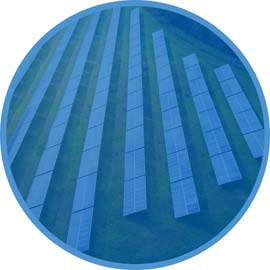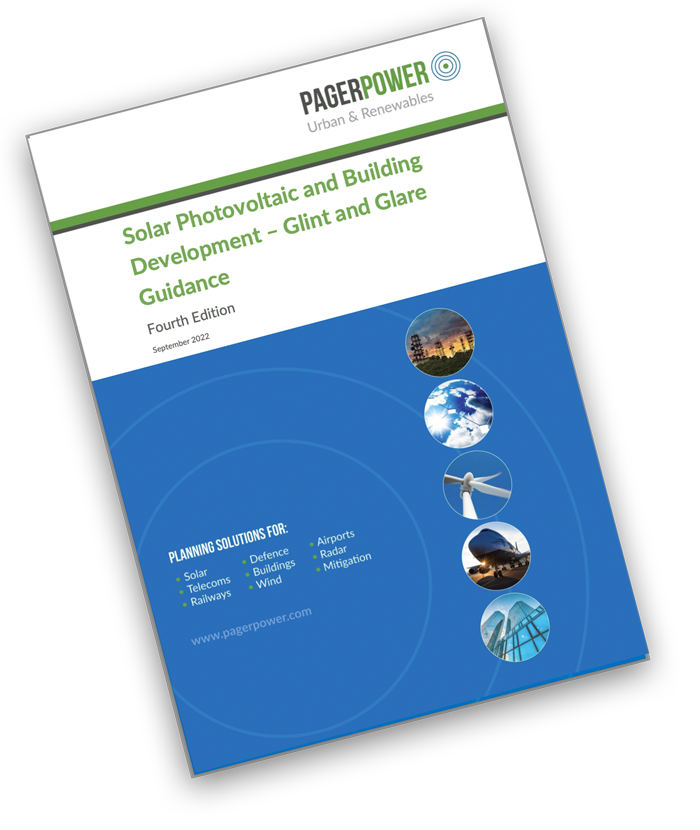Solar Intensity Calculations
Solar glint and glare assessments quantify the date, time and duration of potential reflections of sunlight by solar panels at various observer positions. In the case of pilots approaching a runway, where reflections are predicted, the intensity of the reflection is key to determining the resulting impact’s acceptability. In a minority of cases, such intensity calculations are required for other receptor types.
Simplistically solar intensity calculations quantify the reflection intensity in terms of the amount of the light energy received at the eye. In order to make the result easier to interpret, the output is categorised as ‘Green’, ‘Yellow’ and ‘Red’, corresponding to increasing levels of intensity. Green glare is acceptable for almost all receptor types, red glare is not acceptable for any receptor. Yellow glare is evaluated in an operational context.
Glint and Glare Optimisation
Reflections of sunlight by solar panels can cause a safety hazard in a development’s vicinity. This is most often a concern for drivers on nearby roads, air traffic controllers and pilots of aircraft on final approach to a runway. The impact upon residential amenity within nearby dwellings can also be a consideration.
Where significant levels of glare are predicted, it can be necessary to re-configure the development to eliminate the unacceptable glare. This is achieved by iterative analysis of varying configurations – specifically azimuth angle and vertical tilt – to identify the configuration that is safe while remaining as close as possible to the optimal layout for generation.
Network Rail (Railway) Assessment
Railway operations are key to transport infrastructure in many countries throughout the world. Solar reflections towards railway lines can be problematic, predominantly for two reasons. Reflected light can cause discomfort and/or distraction to a train driver and could potentially illuminate a railway signal bulb giving the false impression that the signal is on when this is not the case in reality.
Solar photovoltaic developments can receive objections from railway operators on the grounds of safety due to potential reflections. Pager Power offers assessment of these potential issues based on detailed modelling of where and when reflections could occur, along with a determination of impact significance.
MOD Assessment
The Ministry of Defence (MOD) has infrastructure and operations throughout the United Kingdom. This includes military bases, radar installations, low flying training areas, seismic arrays and more. UK developments, including solar photovoltaic parks, can receive objections at the planning stage from the MOD due to impacts on their infrastructure.
Pager Power is well placed to assess potential concerns, having a comprehensive database of MOD infrastructure and extensive experience in dealing with potential concerns. A range of assessments is available, from feasibility assessments to mitigation studies where required.
Environmental Impact Assessment
Developments of a significant scale, including solar photovoltaics require environmental impact assessments. This is typically in the form of an environmental impact assessment report covering a range of topics supported by technical assessments (which are often appended to the main report).
Pager Power has extensive experience in supporting this process, by undertaking the requisite technical analysis and/or preparation of chapters for the environmental impact assessment report itself.
Radar Impact Assessments
New structures that are built near radar installations can affect their operation, predominantly via obstruction or reflection of the radar signal. In some cases, emissions from a new development itself can be of concern in the context of electromagnetic interference.
Solar farms can be subject to objections from radar operators, particularly at close range where there is an unobstructed path from the radar to the panels. Technical assessment can quantify the level of effect on specific radar installations.
Stakeholder Consultation
In order to understand the constraints on a proposed solar development, various technical information is required. Some of this is the public domain, and much is contained within Pager Power’s proprietary databases. In some cases, further information is required from stakeholders.
Pager Power is well placed to undertake stakeholder consultation as it pertains to proposed developments, having developed longstanding relationships with many stakeholders around the world. We have established relationships with many stakeholders including Airport & Aerodrome Operators, Network Rail and worldwide Aviation Authorities.
Support and Advice
Pager Power offers a range of technical assessments, each designed to address common issues that can otherwise constrain solar development. However, specific scenarios are all different and bespoke approaches are required as often as not.
Pager Power is well placed to provide ad-hoc support and advice in a number of ways. Our approach is to be flexible in order to support individual needs. Common types of support include teleconferences, technical presentations, review of external documentation, provision of written technical input and representation at appeal.
Meetings and negotiations
Face-to-face meetings are a common requirement for proposed solar developments where initial concerns have been highlighted. In many cases, this can be beneficial for all parties concerned. Pager Power has extensive experience in technical meetings with stakeholders and project development teams.
Common areas that require discussion include technical impacts and their operational significance, along with proposed solutions/conditions and logistical arrangements for implementing them. Often, the primary benefit of such meetings is to communicate the priorities of all parties and demonstrate the level of commitment to ensuring new developments can coexist safely with the existing environment.
THE SECTORS WE SERVE




How can we help you today?




